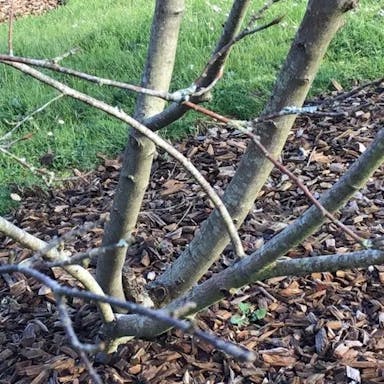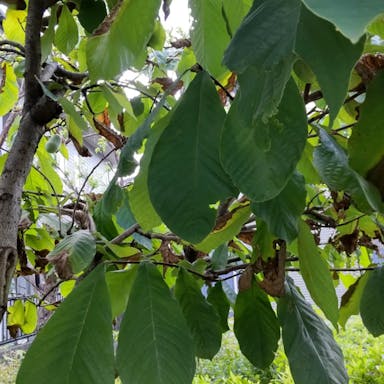Bladdernut, scientifically known as Staphylea pinnata, is a deciduous shrub or small tree that belongs to Staphyleaceae family. It is found in areas and along waterways. The leaves are compound and opposite. The small flowers are fragrant and bloom late spring to early summer. The fruit is a three-lobed capsule. When mature, it turns brown and opens to release shiny black seeds. The plant grows in various soils and likes moisture, sun to shade. It is used in landscaping for looks and flowers. Symbolically, it represents protection and healing. It has ornamental value for gardens and parks.
Bladdernut
- Scientific name
- Staphylea pinnata
Basic Information
- Staphyleaceae Family Staphylea Genus Bladdernut Species
- Staphyleaceae > Staphylea > Staphylea pinnata
- 83%
- The Completeness of This Encyclopedia
Please help us complete the encyclopedia, Terrarium is a encyclopedia service to be completed with everyone in the world. Currently, this page is 83% complete. For more information on how to contribute, please click here.
- Small tree
- Tree
- Height
- 600cm ~ 1000cm
- Flower Color
- Leaf Color
- Anthesis
- spring
- Sunlight Exposure
Full Sun Long hours of sunlight from morning to afternoon Partial Shade A location in the shade of a tree or where either the morning or afternoon is shaded Full Shade A place where there is no direct sunlight
- Full Sun
- Hardiness Zones
This is an indicator to know to which zone each plant can winter. Knowing the zone of each plant gives you an idea of the cold temperature resistance when grown in the ground without a roof. 2: -42.7 to -40.0 3: -39.9 to -34.4 4: -34.3 to -28.9 5: -28.8 to -23.3 6: -23.2 to -17.8 7: -17.7 to -12.2 8: -12.1 to -6.7 9: -6.6 to -1.1 10: -1.0 to 4.4 11: 4.5 to 10.0
- 5-8
- Cold resistance
- Good
- Heat resistance
- Fair
- Habitat of origin
- Europe
- Growth Rate
- Normal
What is Bladdernut (Staphylea pinnata)?
What is Bladdernut (Staphylea pinnata)
Flower meaning
The Bladdernut plant in America expresses separation or farewell in the flower language. Different plants and flowers have specific meanings and emotions in the language of flowers. For example, the Bladdernut plant may convey feelings of parting when moving away or leaving. However, the language of flowers can vary based on cultural and historical contexts.
Calendar of Bladdernut (Staphylea pinnata)
Calendar
Bladdernut is often blooming in spring season during April and May. During this time, the US native plant produces white flower clusters. The prettiest flowers are in May. Flowers need a few weeks to fully bloom. Providing sunlight, water and nutrients prolongs blooming. Dead material removal also aids new growth.
How to grow Bladdernut (Staphylea pinnata)
Watering
Bladdernut plants require regular watering to flourish. Sufficient frequency of watering for Bladdernut is once every 7 to 10 days during the growing period, which commonly spans from spring to early autumn. During this period, the soil should be kept consistently moist but not waterlogged. It is key to confirm that the first few inches of soil remain damp between watering sessions. Bladdernut plants generally need approximately 1 inch of water per week. However, it is crucial to adapt the watering schedule based on the detailed needs of the plant and the prevailing weather conditions. During the dormant season in winter, Bladdernut plants need less frequent watering. It is prudent to decrease the watering frequency to once every 2 to 3 weeks, permitting the soil to dry out slightly between waterings. Overall, preserving appropriate soil moisture is the key to the successful cultivation of Bladdernut plants.
Soil and Fertilizer
The Bladdernut, commonly grown in Multistate's northern regions, lives in a range of earth conditions. The plant enjoys terrain where excess water flows freely and measures between 5.5 and 7.5 on the scale gauging acidity. Enriching the soil with decomposed organic substances assists moisture retention. To encourage prime maturation, professionals advocate a fertilizer containing comparable amounts of nitrogen, phosphorus, potassium early in the time preceding rapid shoot development. The quantities depend on the individual plant's age and size. Recently planted Bladdernut may receive a tablespoon; greater quantities suit mature specimens. Careful distribution around stems prevents harm. Absorption requires ample watering after fertilizer dispersal. Periodic replenishment using slow release fertilizer benefits the production of foliage and flowers. Adherence to cautious protocols optimizes plant health.
Sunlight and Place
Bladdernut, a plant species, exhibits moderate cold tolerance and can withstand temperatures as low as -20°C. However, it is not highly heat tolerant. The optimum temperature range for Bladdernut growth is between 15°C and 25°C. During summer, Bladdernut prefers a partially shaded location to protect it. It can tolerate full sun exposure but may require additional watering. In winter, Bladdernut can withstand cold temperatures but benefits from protection against harsh winds and frost. Bladdernut thrives in areas with moderate sunlight, receiving around 4 to 6 hours of direct sunlight per day. Insufficient sunlight may result in reduced growth and flowering. It is important to provide adequate sunlight to ensure optimal development and overall health of the plant.
Advanced Information of Bladdernut (Staphylea pinnata)
Pruning
Bladdernut, a plant commonly found in North America, benefits from regular pruning and cutting back. The plant is less likely to experience stress or damage from pruning if pruned when dormant. Cut back dead or damaged branches to a healthy bud or branch. After pruning, best to remove debris and apply mulch around the base of the plant. This helps retain moisture and suppress weed growth. Regular pruning and cutting back help Bladdernut thrive and maintain overall health and appearance.
Planting and Harvest
Bladdernut, scientifically known as Staphylea, is a deciduous shrub that can be potted or planted in the ground. Select large container sufficient for the root system when choosing potting. The pot requires drainage holes prevent waterlogged soil. Start by filling container well-draining potting mix when potting Bladdernut. Gently remove from nursery container without damaging roots. Place in center of the pot and fill remaining space with potting mix, matching previous level. Firmly press soil around plant eliminate air pockets. Water thoroughly after potting and continue watering regularly, allowing one inch of soil dry out between waterings. Partial shade to full sun is preferred, so place potted plant in adequate sunlight. Select pot one size larger than current pot when repotting Bladdernut. Follow same procedure as initial potting, keeping plant at same level as before. Repotting typically done every 2-3 years or plant outgrows container. Overwatering can cause root rot, while underwatering results in wilting and leaf drop. Consistent care important to avoid decline. Regular pruning helps maintain shape and size. In conclusion, Bladdernut can be successfully potted or planted in ground. Proper procedures like suitable container, well-draining soil, adequate sunlight and water essential for health. Repotting and pruning maintains vigor.
Propagation
Bladdernut can be propagated through different methods like sowing seeds. Leaf cuttings also can be used to make new plants. The focus is on getting plant material for propagation.
Pests and Diseases
Bladdernut (Staphylea spp.) is susceptible to various pests and diseases. One common insect that affects Bladdernut is the Bladdernut sawfly (Heterarthrus spp.). This insect feeds on the plant leaves. It can weaken the plant's health. To prevent problems, check the plant often for signs of these insects. If found, insecticidal soap or horticultural oil can help control them. Another insect that affects Bladdernut is the Bladdernut lace bug (Corythucha spp.). They feed underneath the leaves. This turns the leaves yellow with dots. To prevent problems, keep the plant healthy. Water and fertilize correctly. Also, insecticidal soap or neem oil can control the bugs. Bladdernut can also get fungal diseases like powdery mildew (Erysiphe spp.) and leaf spot (Phyllosticta spp.). Powdery mildew coats the leaves in white powder. Leaf spot makes dark spots on the leaves. To prevent disease, allow good air flow. Avoid watering from above. This reduces humidity and infection chances. Fungicide sprays may help if diseases are bad. In summary, Bladdernut can be affected by insects like sawflies and lace bugs. It can also get fungal diseases like powdery mildew and leaf spot. Check plants often, care for them properly, and use appropriate treatments to prevent and manage problems.
Habitat of Bladdernut (Staphylea pinnata)
Habitat
Toxicity of Bladdernut (Staphylea pinnata)
Health Benefits
- edible
- Inedible
- Toxic
- No toxicity
NO DATA
Toxic for dogs and cats
NO DATA
Q&A of Bladdernut (Staphylea pinnata)
- The Best Tips for Caring for Bladdernut Leaves?
To form the best wellbeing of Bladdernut leaves, or Staphylea pinnata, it's vital to provide them with free draining ground and incomplete to complete illumination. Normal watering is essential, but circumvent overwatering as it can guide to root disease. Cut back the vegetation every year to hold its form and take away any expired or sick leaves. Finally, observe the vegetation for bugs and illnesses, and handle them fast with natural or chemical solutions as required.
- What Is Bladdernut Fruit and How Is It Used?
Bladdernut fruit, Staphylea pinnata by name, inflates a small, round capsule containing various seeds. It inhabits Europe and Asia. The fruit's distinctive form and pretty white blossoms make it decorative. The fruit stays uneaten since it tastes bitter. However, traditional medicine uses it as a diuretic and anti-inflammatory. Bladdernut wood also crafts small goods like tool handles and walking sticks.
- How to Successfully Germinate Bladdernut Seeds?
To successfully germinate Bladdernut seeds, or Staphylea pinnata, it's crucial to first soak the seeds in warm water for 24 hours. This process, known as stratification, helps to break the seed's dormancy and stimulate germination. Afterward, locate the seeds in an adequately draining soil combination, approximately 1-2 cm profound. Confirm that soil stays damp however not waterlogged, as this could prompt seed rot. Spot the planted seeds in a place with radiant warmness and a steady temperature of around 20-25°C. Germination might happen inside 2-3 weeks. Remember, perseverance is basic in the germination cycle, as a few seeds may require more time to sprout.
- Where to Find Bladdernut Trees for Sale?
Bladdernut trees, scientifically known as Staphylea pinnata, can be purchased from various websites and hometown plant shops. Buyers should make sure they are in stock, as these trees are not kept on hand very often. Also, public gardens and tree identification centers might sell them or know suppliers. Before getting one, check that the tree will prosper in your area's weather and dirt. It's important to confirm they are available, since these trees have particular growing needs, so they are not usually carried. In addition, botanical gardens and arboretums could sell these trees or offer data on purchasing them. Be sure the tree works in your local conditions before getting it.
- Is there a recommended way to choose Bladdernut?
Bladdernut, scientifically known as Staphylea pinnata, is a deciduous shrub that belongs to the Staphyleaceae family. When choosing types of Bladdernut, one must think about how tall they grow, their size, and the color of their flowers. One well-liked kind is the 'Rosea' Bladdernut. It has pink flowers and can grow to be 10-15 feet high. Another kind is the 'Fastigiata'. It grows more straight up and can get up to 20 feet tall. When you buy Bladdernut seeds, you need to make sure they are new and will grow. Look for seeds that are plump and firm, not shriveled or discolored. It is a good idea to soak the seeds in water for 24 hours before planting. This can help them sprout better. For Bladdernut seedlings, pick ones with a good root system and healthy leaves. Avoid seedlings with yellow or wilted leaves. This could mean they are not healthy. Transplant the seedlings into soil that drains well. Water them regularly until they settle in. By carefully picking the kinds of Bladdernut, seeds, and seedlings, you can make sure your Bladdernut garden does well.












